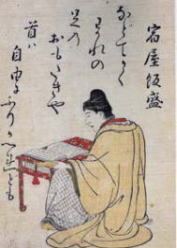 | ||
The evolution of ky ka suigetsu
Kyōka (狂歌, "wild" or "mad poetry") is a popular, parodic subgenre of the tanka form of Japanese poetry with a metre of 5-7-5-7-7.
Contents
Background
In much the same way poets in the kanshi style (Chinese poetry by Japanese poets) wrote humorous kyōshi poems, poets in the native Japanese waka style composed humorous poems in the 31-syllable style. During the Edo period there were two major branches of kyōka, one based in Edo (modern Tokyo), and Naniwa kyōka in the Kansai region.
Naniwa kyōka arose in Kyoto in the 16th century, at first practised by aristocrats such as Matsunaga Teitoku (1571–1654). It later found practitioners amongst commoners and centred in Osaka, whose earlier name Naniwa lent its name to the regional form.
In the late 18th century, the economic policies of senior councillor Tanuma Okitsugu led to a sense of liberations, and various publishing forms flourished during this time. Edo samurai poets such as Yomo no Akara (1749–1823), Akera Kankō (1740–1800), and Karakoromo Kishū (1743–1802) gathered for meetings and contests of kyōka poetry, which they took to publishing in the following decade. The earliest and largest collection was the Manzai kyōka-shū (万載狂歌集, "Wild Poems of Ten Thousand Generations") that Akara edited and had published in 1783. Kyōka in Edo reached its zenith during the Tenmei era (1781–89) Numerous kyōka appear throughout Jippensha Ikku's comic kokkeibon novel Tōkaidōchū Hizakurige (1802–22).
Kyoka Form
Most of the humour lay either in placing the vulgar or mundane in an elegant, poetic setting, or by treating a classical subject with common language or attitudes. Puns, wordplay, and other word games were frequently employed—and make translation difficult. A common technique was honkadori (本歌取り), in which a classical poem was taken as a base (or honka 本歌) and altered to give it a vulgar twist. Though its popularity spread to commoners, kyōka required considerable classical education and thus reached a limited audience; its popularity did not last into the modern era.
